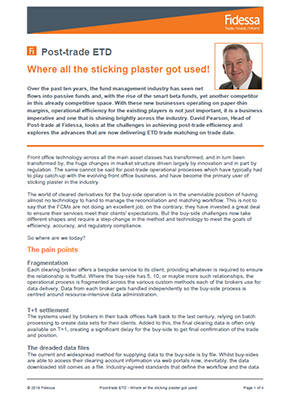
Post-trade ETD – where all the sticking plaster got used!
The fund management industry’s shift to passive funds and embrace of smart-beta funds over the past decade or so has shaved margins to the extreme. In this environment, operational efficiency becomes an existential issue.
Across a broad swathe of asset classes, front-office technologies have kept pace with massive changes in market structure driven by regulation and innovation. But post-trade business processes continue to play catch-up.
Nowhere is this more true than in exchange-traded derivatives, where few technology options are available to aid buy-side firms as they face a myriad of challenges as they strive to ensure efficiency, accuracy and regulatory compliance.
The use of multiple clearing brokers is fragmenting buy-side operational processes. The continued T+1 availability of clearing data is introducing delays in delivering final trade and position confirmations to clients. The reliance by brokers on files for data delivery is blocking development of a more efficient messaging standard.
And there’s more.
The buy-side’s reliance on manually processed broker-provided clearing data makes fund managers’ work flows prone to errors. Commission management is typically handled outside of the post-trade process, requiring fund managers to re-integrate this information after the event for fund administration and client reporting. And the increasing complexity of the execution landscape – with funds trending towards more block trades – is making it difficult to calculate a true price.
All of these issues are conspiring to disrupt work flows and introduce operational risk and costs into the post-trade process.
Market practitioners, however, are working to address inefficiencies in post trade. For a discussion of the challenges currently facing players in the ETD space and industry initiatives designed to address them, please download this free paper by clicking here.

